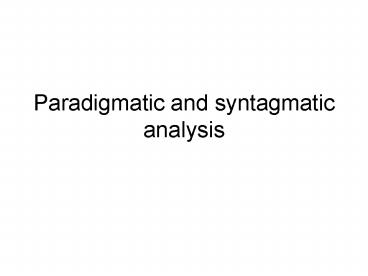Paradigmatic and syntagmatic analysis
1 / 15
Title:
Paradigmatic and syntagmatic analysis
Description:
Paradigmatic analysis is the analysis of paradigms embedded in the text rather ... Observations taken from Gemma Penn, 'Semiotic Analysis of Still Images' in Bauer, ... –
Number of Views:2612
Avg rating:3.0/5.0
Title: Paradigmatic and syntagmatic analysis
1
Paradigmatic and syntagmatic analysis
2
Paradigmatic analysis
vertical metaphor selective/associative bipolar
oppositions meaning by context (media, genre)
3
Syntagmatic analysis
horizontal metonymy combinative composed of
paradigms narrative
4
Vertical / horizontal
PARADIGMS
PARADIGMS
NARRATIVE
SYNTAGMS
5
Paradigmatic and syntagmatic
- Paradigmatic
- A dissimilar thing that can be exchanged for the
thing of which the value is to be determined - Syntagmatic
- Similar things that can be compared with the
thing of which the value is to be determined
6
Paradigmatic analysis
- Paradigmatic analysis is the analysis of
paradigms embedded in the text rather than of the
surface structure (syntax) of the text which is
termed syntagmatic analysis. Paradigmatic
analysis often uses commutation tests, i.e.
analysis by substituting words of the same type
or class to calibrate shifts in connotation.
7
Syntagmatic analysis, syntax
- In semiotics syntagmatic analysis is analysis of
syntax or surface structure (Syntagmatic
structure), rather than paradigms as in
paradigmatic analysis. This is often done through
commutation tests. - Syntax, originating from the Greek words s??
(syn, meaning "co-" or "together") and t????
(táxis, meaning "sequence, order, arrangement"),
can in linguistics be described as the study of
the rules, or "patterned relations" that govern
the way the words in a sentence come together. It
concerns how different words (which, going back
to Dionysios Thrax, are categorized as nouns,
adjectives, verbs, etc.) are combined into
clauses, which, in turn, are combined into
sentences.
8
Commutation test
- According to Daniel Chandler, the commutation
test may involve any of four basic
transformations which, to a greater or lesser
extent, involve modification of the syntagm - Paradigmatic transformations
- substitution
- transposition
- Syntagmatic transformations
- addition
- deletion.
9
Syntagms and paradigms
- Syntagms defined as a coherent sequence of signs
- A sentence (Jack jumped over the candlestick.)
- Whole story lines as in sit coms
- Paradigmatic analysis looks at sets of signs and
how they come to stand for something else
10
Paradigmatic and syntagmatic (semiotic) analysis
- The value of a term within a text depends on the
contrasts with alternative terms that have not
been chosen (paradigmatic or associative
relations) - The value of a term depends on the relations with
the other terms that precede and follow it
(syntagmatic relations). - A paradigm, or associative set, is a group of
terms that are related or similar, and different.
Observations taken from Gemma Penn, Semiotic
Analysis of Still Images in Bauer, Martin W. and
Gaskell, George, Eds. Qualitative Researching
with Text, image and Sound A practical Handbook.
Sage London, 2000, p. 227ff
11
Paradigmatic and syntagmatic (semiotic) analysis
- The meaning of a term is delimited by the set of
unchosen terms and by the way in which the chosen
terms are combined with each other to create a
meaningful whole.
Observations taken from Gemma Penn, Semiotic
Analysis of Still Images in Bauer, Martin W. and
Gaskell, George, Eds. Qualitative Researching
with Text, image and Sound A practical Handbook.
Sage London, 2000, p. 227ff
12
Example Alices hat is green.
Syntagm
- People Clothing to be Color
- Alices hat is green.
- My coat isnt yellow.
- The vicars pyjamas were pink.
Paradigm
The value of each term is determined by its place
in the syntagm--by the other terms in the
sentence that precede and follow it. Also by the
set of alternative terms that might replace it.
13
Syntagmatic and Associative Relations
- In discourse, on the one hand, words acquire
relations based on the linear nature of language
because they are chained together. ... - Combinations supported by linearity are syntagms.
The syntagm is always composed of two or more
consecutive units .... In the syntagm a term
acquires its value only because it stands in
opposition to everything that precedes or follows
it, or to both. - Outside discourse, on the other hand, words
acquire relations of a different kind. Those
that have something in common are associated in
memory, resulting groups are marked by diverse
relations. ... - We see that the co-ordinations formed outside
discourse differ strikingly from those formed
inside discourse. Those formed outside discourse
are not supported by linearity. Their seat is in
the brain they are a part of the inner
storehouse that makes up the language of each
speaker. They are associative relations. (p.
123).
14
Syntagmatic and Associative Relations
Associative (Paradigmatic) Axis
C
C
C
Syntagmatic Axis
A
B
C
D
E
15
Linguistic Values
- Values are composed of
- A dissimilar thing that can be exchanged for the
thing of which the value is to be determined - Similar things that can be compared with the
thing of which the value is to be determined
Signified
Signified
Signified
Signifier
Signifier
Signifier































